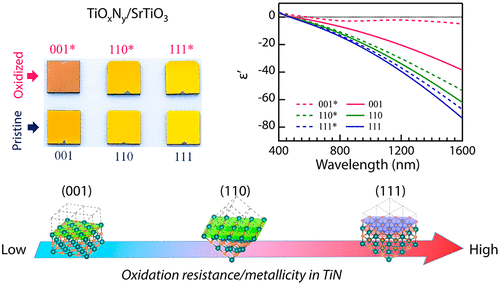当前位置:
X-MOL 学术
›
ACS Photonics
›
论文详情
Our official English website, www.x-mol.net, welcomes your feedback! (Note: you will need to create a separate account there.)
Crystal Orientation-Dependent Oxidation of Epitaxial TiN Films with Tunable Plasmonics
ACS Photonics ( IF 7 ) Pub Date : 2021-02-24 , DOI: 10.1021/acsphotonics.0c01827 Ruyi Zhang 1, 2 , Qian-Ying Ma 1, 3 , Haigang Liu 4 , Tian-Yu Sun 1 , Jiachang Bi 1 , Yang Song 1, 2 , Shaoqin Peng 1, 2 , Lingyan Liang 1 , Junhua Gao 1 , Hongtao Cao 1 , Liang-Feng Huang 1 , Yanwei Cao 1, 2
ACS Photonics ( IF 7 ) Pub Date : 2021-02-24 , DOI: 10.1021/acsphotonics.0c01827 Ruyi Zhang 1, 2 , Qian-Ying Ma 1, 3 , Haigang Liu 4 , Tian-Yu Sun 1 , Jiachang Bi 1 , Yang Song 1, 2 , Shaoqin Peng 1, 2 , Lingyan Liang 1 , Junhua Gao 1 , Hongtao Cao 1 , Liang-Feng Huang 1 , Yanwei Cao 1, 2
Affiliation

|
Titanium nitride (TiN) is a paradigm of refractory transition metal nitrides with great potential in vast applications. Generally, the plasmonic performance of TiN can be tuned by oxidation, which was thought to be only temperature-, oxygen partial pressure-, and time-dependent. Regarding the role of crystallographic orientation in the oxidation and resultant optical properties of TiN films, little is known thus far. Here we reveal that both the oxidation resistance behavior and the plasmonic performance of epitaxial TiN films follow the order of (001) < (110) < (111). The effects of crystallographic orientation on the lattice constants, optical properties, and oxidation levels of epitaxial TiN films have been systematically studied by combined high-resolution X-ray diffraction, spectroscopic ellipsometry, X-ray absorption spectroscopy, and X-ray photoemission spectroscopy. To further understand the role of crystallographic orientation in the initial oxidation process of TiN films, density-functional-theory calculations are carried out, indicating the energy cost of oxidation is (001) < (110) < (111), consistent with the experiments. The superior endurance of the (111) orientation against mild oxidation can largely alleviate the previously stringent technical requirements for the growth of TiN films with high plasmonic performance. The crystallographic orientation can also offer an effective controlling parameter to design TiN-based plasmonic devices with desired peculiarity, for example, superior chemical stability against mild oxidation or large optical tunability upon oxidation.
中文翻译:

具有可调谐等离子体的外延TiN薄膜的晶体取向依赖性氧化
氮化钛(TiN)是耐火过渡金属氮化物的典范,在广泛的应用中具有巨大的潜力。通常,TiN的等离子体性能可以通过氧化来调节,氧化被认为仅取决于温度,氧气分压和时间。关于晶体取向在TiN膜的氧化和所得光学性质中的作用,迄今知之甚少。在这里,我们揭示了外延TiN薄膜的抗氧化性能和等离子体性能均遵循(001)<(110)<(111)的顺序。结合高分辨率X射线衍射,光谱椭圆偏振法,X射线吸收光谱法,系统地研究了晶体取向对外延TiN薄膜的晶格常数,光学性质和氧化水平的影响,和X射线光发射光谱。为了进一步了解晶体取向在TiN薄膜初始氧化过程中的作用,进行了密度泛函理论计算,表明氧化的能量成本为(001)<(110)<(111),与实验一致。(111)取向对轻度氧化的优异耐受性可以大大缓解先前对具有高等离激元性能的TiN薄膜生长的严格技术要求。晶体学取向还可以提供有效的控制参数,以设计具有所需特性的基于TiN的等离激元器件,例如,对轻度氧化具有优异的化学稳定性或在氧化时具有较大的光学可调性。为了进一步了解晶体取向在TiN薄膜初始氧化过程中的作用,进行了密度泛函理论计算,表明氧化的能量成本为(001)<(110)<(111),与实验一致。(111)取向对轻度氧化的优异耐受性可以大大缓解先前对具有高等离激元性能的TiN薄膜生长的严格技术要求。晶体学取向还可以提供有效的控制参数,以设计具有所需特性的基于TiN的等离激元器件,例如,对轻度氧化具有优异的化学稳定性或在氧化时具有较大的光学可调性。为了进一步了解晶体取向在TiN薄膜初始氧化过程中的作用,进行了密度泛函理论计算,表明氧化的能量成本为(001)<(110)<(111),与实验一致。(111)取向对轻度氧化的优异耐受性可以大大缓解先前对具有高等离激元性能的TiN薄膜生长的严格技术要求。晶体学取向还可以提供有效的控制参数,以设计具有所需特性的基于TiN的等离激元器件,例如,对轻度氧化具有优异的化学稳定性或在氧化时具有较大的光学可调性。表明氧化的能量成本为(001)<(110)<(111),与实验一致。(111)取向对轻度氧化的优异耐受性可以大大缓解先前对具有高等离激元性能的TiN薄膜生长的严格技术要求。晶体学取向还可以提供有效的控制参数,以设计具有所需特性的基于TiN的等离激元器件,例如,对轻度氧化具有优异的化学稳定性或在氧化时具有较大的光学可调性。表明氧化的能量成本为(001)<(110)<(111),与实验一致。(111)取向对轻度氧化的优异耐受性可以大大缓解先前对具有高等离激元性能的TiN薄膜生长的严格技术要求。晶体学取向还可以提供有效的控制参数,以设计具有所需特性的基于TiN的等离激元器件,例如,对轻度氧化具有优异的化学稳定性或在氧化时具有较大的光学可调性。
更新日期:2021-03-17
中文翻译:

具有可调谐等离子体的外延TiN薄膜的晶体取向依赖性氧化
氮化钛(TiN)是耐火过渡金属氮化物的典范,在广泛的应用中具有巨大的潜力。通常,TiN的等离子体性能可以通过氧化来调节,氧化被认为仅取决于温度,氧气分压和时间。关于晶体取向在TiN膜的氧化和所得光学性质中的作用,迄今知之甚少。在这里,我们揭示了外延TiN薄膜的抗氧化性能和等离子体性能均遵循(001)<(110)<(111)的顺序。结合高分辨率X射线衍射,光谱椭圆偏振法,X射线吸收光谱法,系统地研究了晶体取向对外延TiN薄膜的晶格常数,光学性质和氧化水平的影响,和X射线光发射光谱。为了进一步了解晶体取向在TiN薄膜初始氧化过程中的作用,进行了密度泛函理论计算,表明氧化的能量成本为(001)<(110)<(111),与实验一致。(111)取向对轻度氧化的优异耐受性可以大大缓解先前对具有高等离激元性能的TiN薄膜生长的严格技术要求。晶体学取向还可以提供有效的控制参数,以设计具有所需特性的基于TiN的等离激元器件,例如,对轻度氧化具有优异的化学稳定性或在氧化时具有较大的光学可调性。为了进一步了解晶体取向在TiN薄膜初始氧化过程中的作用,进行了密度泛函理论计算,表明氧化的能量成本为(001)<(110)<(111),与实验一致。(111)取向对轻度氧化的优异耐受性可以大大缓解先前对具有高等离激元性能的TiN薄膜生长的严格技术要求。晶体学取向还可以提供有效的控制参数,以设计具有所需特性的基于TiN的等离激元器件,例如,对轻度氧化具有优异的化学稳定性或在氧化时具有较大的光学可调性。为了进一步了解晶体取向在TiN薄膜初始氧化过程中的作用,进行了密度泛函理论计算,表明氧化的能量成本为(001)<(110)<(111),与实验一致。(111)取向对轻度氧化的优异耐受性可以大大缓解先前对具有高等离激元性能的TiN薄膜生长的严格技术要求。晶体学取向还可以提供有效的控制参数,以设计具有所需特性的基于TiN的等离激元器件,例如,对轻度氧化具有优异的化学稳定性或在氧化时具有较大的光学可调性。表明氧化的能量成本为(001)<(110)<(111),与实验一致。(111)取向对轻度氧化的优异耐受性可以大大缓解先前对具有高等离激元性能的TiN薄膜生长的严格技术要求。晶体学取向还可以提供有效的控制参数,以设计具有所需特性的基于TiN的等离激元器件,例如,对轻度氧化具有优异的化学稳定性或在氧化时具有较大的光学可调性。表明氧化的能量成本为(001)<(110)<(111),与实验一致。(111)取向对轻度氧化的优异耐受性可以大大缓解先前对具有高等离激元性能的TiN薄膜生长的严格技术要求。晶体学取向还可以提供有效的控制参数,以设计具有所需特性的基于TiN的等离激元器件,例如,对轻度氧化具有优异的化学稳定性或在氧化时具有较大的光学可调性。



























 京公网安备 11010802027423号
京公网安备 11010802027423号